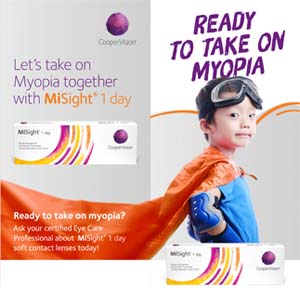MiSight, New Contact Lens That Slows Myopia Progression In Children Approved By US FDA
Source: Thailand Medical News Nov 19, 2019 6 years, 2 days, 13 hours, 17 minutes ago
The first contact lens indicated to slow the progression of myopia in children ages 8 to 12 years, called
MiSight, has been approved by the U.S. Food and Drug Administration last week.

The disposable single-use soft contact lenses should be discarded after one-day use and are not intended to be worn overnight. They are indicated to correct and slow progression of myopia in children with
healthy eyes, the FDA noted. Like a standard corrective lens, one part of the
MiSight contact lens corrects the refractive error to improve distance vision. Concentric peripheral rings in the lens also focus part of the light in front of the retina to reduce the stimulus causing myopia progression.
The US FDA approved
MiSight based on data from a prospective clinical trial at four clinical sites and real-world evidence. Safety and effectiveness of
MiSight were demonstrated in a three-year randomized, controlled clinical trial of 135 children ages 8 to 12 years old at the start of treatment with
MiSight or a conventional soft contact lens.
During the entire three years, children who wore
MiSight lenses had less progression of myopia compared with those who wore conventional soft contact lenses. Researchers also found that children who wore
MiSight lenses had less change in the axial length of the eyeball at each yearly checkup. No serious ocular adverse events were reported for any patients.
The US FDA also reviewed real-world data from a retrospective analysis of medical records of 728 children aged 8 to 12 years old from seven community eye care clinics. Data showed a similar rate of corneal ulcer cases in children who wore
MiSight as in adults who wear contact lenses daily.
Thailand Medical News notes that the approval was granted to CooperVision, the patent holders and manufacturers of these contact lenses.The company also told
Thailand Medical News that the products would be available in Asia by mid 2020 as Asia is actually the market with a huge population of children having eyesight problems.
